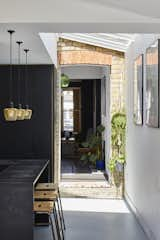The brick pictured is original to the home. “We wanted to connect our new extension against the retained rear wall of our house as a feature and acknowledgement of the original building,” says Richard. “The doorway/opening is actually the original doorway into our side alleyway and garden—we just removed the doors and tidied up slightly.”
"Tourists," says Tablet Hotels, "is a ’60s motor lodge reborn as a very modern, very hip little country boutique hotel. Its name was inspired by an old ‘Tourists Welcome’ sign, and the aim is to remove some of the stigma around the term—we can’t be locals everywhere. Its partners are drawn from several disparate worlds—from hospitality and development to chef Cortney Burns and Wilco bassist John Stirratt—who may be tourists in the hotel business but boast authentic cultural connections. The vibe is pared-down but stylish, with a modernist simplicity but a rustic edge, studiously avoiding urban opulence and midcentury modernist kitsch. In its eclectic acknowledgement of its disparate influences it feels somehow timeless, and strikes a balance between summer camp conviviality and the quiet you expect of a proper rural retreat."
AIA architect David Hertz, known for 747 Wing House, looked to the structure of a butterfly wing when designing this Venice home. The inverted roof of Silver Triangle House (or Butterfly House) captures water that collects in a sump and is used for subsurface irrigation. The roof is just one of the home's sustainable features, which, Hertz says, "are not compromises to the design; they're part of the design." Photo by Laura Doss.
do it: the compendium, Independent Curators International (ICI), New York and D.A.P./Distributed Art Publishers, Inc., May 2013, 448 pages. ISBN: 978-1-938922-01-5. Foreword and acknowledgements by Kate Fowle and Frances Wu Giarratano. Introduction by Hans Ulrich Obrist. Essays by Bruce Altshuler, Hu Fang, Virginia Perez-Ratton, and Elizabeth Presa. Available to purchase at Curators International.








